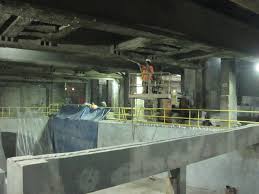Steel beams, columns, floor decks, and other structural components are vital parts of industrial facilities. However, exposed steel rapidly loses strength and stability when subjected to extreme heat during a fire event. Implementing rigorous fireproofing solutions is crucial for maintaining structural integrity and preventing catastrophic collapse.
Fortunately, advanced materials and technologies enable highly effective, customized protection against blazes. Continue reading this article to learn about cutting-edge steel fireproofing systems that defend critical infrastructure.
Table of Contents
Various Steel Fireproofing Technologies
- Intumescent Fire Resistive Coatings
Intumescent coatings are specialized fire-retardant paints formulated with organic thermal expansive. When exposed to temperatures approaching 300°F, these protective coatings undergo a chemical reaction, causing them to expand up to 100 times their original thickness, similar to how a loaf of bread dough rises.
The coating transforms into a thick, porous char layer with low thermal conductivity when expanded. It acts as an insulating barrier, slowing heat transfer to the underlying steel for over two hours, even in extreme fire conditions. This provides critical protection from heat damage and loss of structural integrity.
Modern intumescent coatings offer advantages like:
- Aesthetic thin-film application
- Flexible protection for complex shapes
- Available in decorative colors
- Efficient spray application
- Spray-Applied Fire Resistive Materials
Spray-applied fire resistive materials (SFRMs) function like fireproofing insulation for steel. SFRMs are dense cement or fiber mixtures sprayed directly onto beams, columns, and other surfaces. Here are the options:
- Cementitious Fireproofing: This refers to Portland cement-based mixtures blended with vermiculite, perlite, or other lightweight aggregates. Cementitious coatings offer good bond strength to steel but add significant weight. They can achieve bond strengths over 1000 psf.
- Mineral Fiber Fireproofing: Lightweight wool and fiber materials using rock, slag, glass wool, or cellulose. Mineral fibers demonstrate low thermal conductivity, allowing excellent heat resistance over 1000°F with thin layer application. They produce minimal additional loading.
Some key advantages of SFRMs, include:
- Can adhere to complex geometries through spraying
- Provide one to four hours of fire resistance ratings
- Cementitious versions add mass and stability
- Mineral fibers remain lightweight, thermally efficient
While SFRMs perform well, the spray application method often produces a rough, irregular surface. This may not suit aesthetically sensitive steel structures. Smooth, intumescent coatings typically allow a more uniform decorative finish.
Emerging Fire Protection Technologies
In the coming years, several pioneering technologies showcase great promise for more advanced, higher-performance steel fireproofing systems. Intensive R&D by major coatings companies, research institutions, and innovative startups continues to enhance passive protection, create smart functionalities, and develop more sustainable options.
Here are some advanced steel fireproofing technologies:
- Hybrid Intumescent-Ablative Coatings
Hybrid systems combine intumescent expansion resins with ablative cooling pigments and ceramic compounds. Different ingredients sequentially activate as heat increases to absorb heat energy, insulate, and reflect heat. Testing shows hybrids extending protection for up to four hours.
- Self-Healing Intumescents
Experimental self-healing intumescents contain embedded microcapsules with repair agents. If the coating is damaged, capsules rupture and release healing monomers. The monomers flow to fill cracks and bond back as a polymer, maintaining the coating’s protective integrity.
- Thermochromic Smart Coatings
This type of protective coat, as envisioned by researchers, utilizes leuco dye technology. The coating visually changes appearance when rising above a pre-set temperature threshold. This irreversible color shift will visibly alert facility owners and managers if repairs are needed after heat exposure.
Essential Factors When Selecting Steel Fire Protection
Facility managers weigh multiple critical considerations when choosing optimal fireproofing solutions:
- Fire resistance ratings needed to meet international building codes and local regulations
- Temperature resilience required for realistic worst-case fire scenarios
- Complexity of steel member shapes and ease of access for application
- Aesthetic preferences to maintain the desired ambiance and decor
- Long-term inspection, maintenance, and repair requirements
- Total costs, including installation, product lifespan, and potential operational impacts
Industrial site managers also evaluate the operating environment within their unique facilities. This includes analyzing potential fire risks, construction features, production workflow, inspection capabilities, and overall risk tolerance.
By thoroughly assessing their specific risks, operations, and infrastructure, companies can derive tailored fireproofing strategies leveraging advanced intumescent coatings, SFRMs, gypsum boards, and other innovative technologies to safeguard their critical steel assets reliably.
Optimized solutions will meet localized codes, withstand extreme heat, facilitate maintenance, and provide long-lasting protection against catastrophic fire damage.
Protect Your Facility with Steel Fireproofing Solutions
Advanced coatings and professional installation provide peace of mind that operations can continue uninterrupted even in extreme fire events. Don’t leave steel structures vulnerable in a potential emergency. Contact a fire protection solutions provider to discuss innovative materials and custom steel fireproofing recommendations for your specific building requirements, equipment, and processes.
Apart from that, if you are interested to know about Steel Buildings: Robust Structures for Modern Construction then visit our Business category.















